So you have a killer book idea….the next step is taking that small idea and learning how to mindmap for a book in order to set yourself up for success.
Coming up with a writing prompt or story idea that both will interest you and drive sales is probably the hardest part of self-publishing. But that doesn’t mean the process of taking that idea and turning it into a book will be easy.
The first major step in that process is mindmapping, and in this blog, we’re going to explain the best ways of how to mindmap for a book.
Here are the steps to mindmap for a book:
- Understand why you need a mindmap
- Know the benefits of mind-mapping
- Choose your mind-mapping method
- Make a central topic in your mindmap
- Add secondary topics
- Branch out from the secondary topics
- Remember your mindmap will change
- Start your mindmap today
Why do we need to mindmap?
One might wonder why mindmapping is even necessary. First-time authors may find it tedious or boring while other full-time writers might be talented enough to get away with it.
Mindmapping may not be essential to a successful rough draft, but it makes getting to a refined manuscript a whole lot easier.
For a fun relatable metaphor, I would compare it to grocery shopping.
Do you really go to the grocery store without a plan or list of things to buy? Do you aimlessly walk up and down the aisles and just throw whatever looks good into the cart?
Maybe if you’re 10, and Mom’s buying, but most people would probably say they went to the store with the intention to buy certain items. In this comparison, the prepared list before heading to the store is your mindmap.
And from your mindmap, you create your book outline.
For that step, check this out:
Book Outline Template Generator
We’ve already put the brunt work in, creating front matter, and a fill-in-the-blank style book outline template that’s easy to use.
It even has guidance for what to cover in what chapters in order to plot a really good book readers will love.
Fill in your information below to get your outline template!
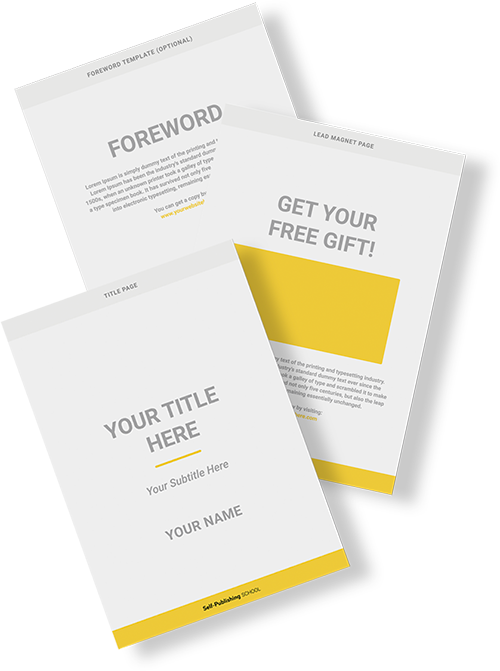
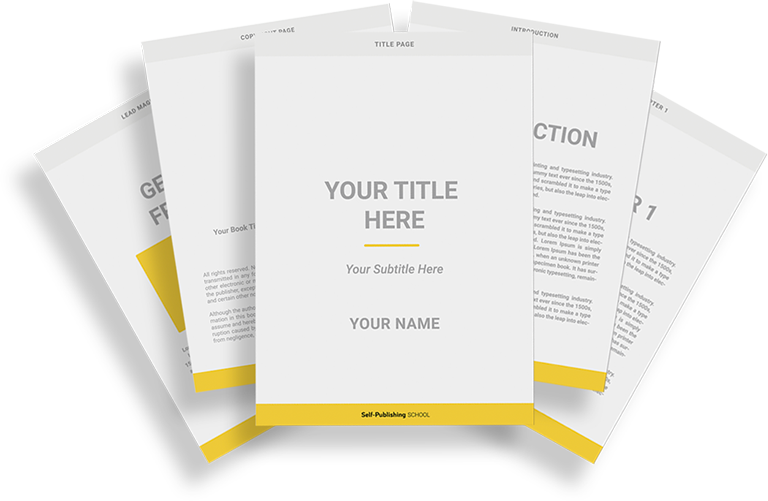
Book Outline Generator
Choose your Fiction or Nonfiction book type below to get your free chapter by chapter outline!
Book Outline Generator
Enter your details below and get your pre-formatted outline in your inbox and start writing today!
CONGRATULATIONS
Thanks for submitting! Check your email for your book outline template.
In the meantime, check out our Book Outline Challenge.
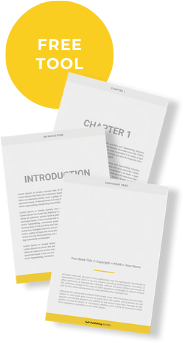
[Pssst! Want to see some of our students’ published books? Check out the SPS Library here!]

Benefits of Mindmapping a Book
Creating a mindmap for your book is essential for setting the writing of your book up for success.
Three main reasons to mindmap:
- Helps to organize thoughts
- Begins to carve out natural book chapters & creates a story structure
- Continues the brainstorming idea process
Without your grocery list, it will take a lot longer walking up and down every aisle to make sure you have everything you want and need in your cart. There’s also a greater possibility that you forget something that you actually do need, and you won’t notice until you’re home.
You can also check out the training below in order to not on understand the importance of this step, but to get a better idea of what you need to set your book up for success:
#1 – Mindmapping helps organize thoughts of your book
After you initially devise the main idea or theme of your book, there’s probably a ton of loose thoughts in your mind of what you want to include.
Before losing them in the cobwebs of your head, write them down in your mindmap!
Mindmapping is all about getting every single, teeny-weeny thought or concept written down on paper. Then you can begin organizing which thought goes where.
Doing this as you write is nearly impossible. Mindmapping helps get all your thoughts on one subject together in one place. That way, they are all grouped together in your book, and you didn’t forget any (like when you forgot to buy peanut butter at the grocery store).
#2 – Mindmapping begins to naturally carve out book chapters
When authors perform the grouping part of mindmapping, they are actually beginning to form the chapters of their book. This happens so seamlessly, that they might not even realize it!
If you tried to skip mindmapping and subsequently, outlining, and just began writing the rough draft, you might not know where to begin.
Well, after mindmapping, because you wrote out all of your thoughts of every idea you had on each topic, you now know which topics are the most important and have the most supporting information.
Start your book with those bigger topics. When you make a switch in topics during your writing, you know it’s time to begin a new chapter.
#3 – Mindmapping ensures you don’t forget anything & provides structure
As I said in the grocery store example, it’s much easier to forget an item that you need in the refrigerator if you’re just aimlessly walking around the store looking for what you need.
If that’s how you approach your book, you will likely forget to discuss a topic or make a point that you wanted.
Devising a plan for your book through mindmapping helps guarantee that doesn’t happen. It also pushes you to continue brainstorming. You may believe you already have enough to cover a certain subject, but going through the mindmapping process will push you to think of even more great ideas to include when writing your book.
Now that you understand the importance of mindmapping, let’s dive into how to mindmap for a book.
Choose Your Method of Mindmapping Your Book
After learning the three key aspects of why mindmapping is necessary to write a strong manuscript, you’re ready to begin your mindmap.
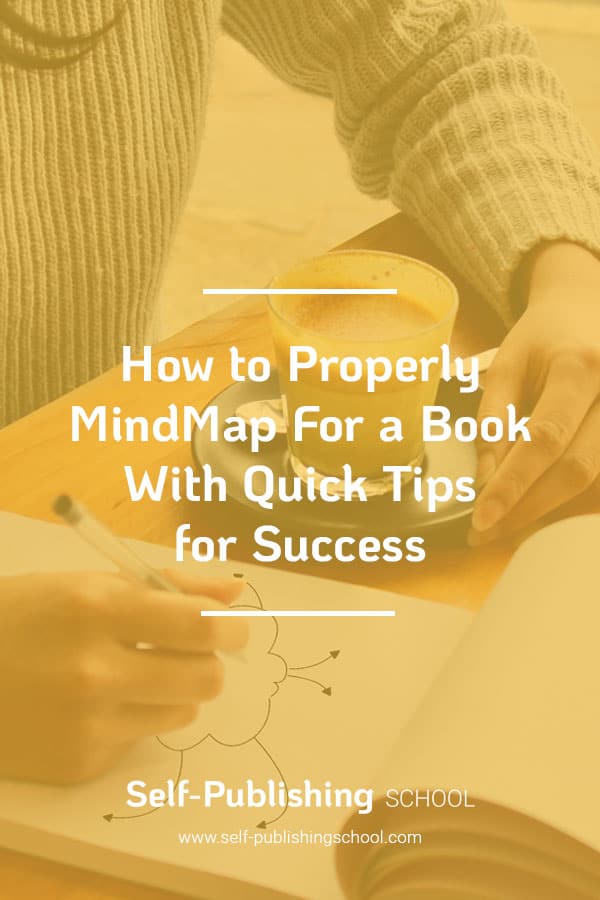
Now, there are essentially two different ways to mindmap. Let’s dive into each one!
The two different ways to mindmap for a book:
- Bubble maps on printer paper
- Post-it notes on a bulletin board
Each author should choose the mindmap technique that makes them feel the most comfortable.
Self-Publishing School teaches to avoid using a computer when performing the mindmap phase. I couldn’t agree more.
Surely, it can be done on a laptop or a tablet, especially an interactive one where the user can use his fingers to write and draw. But I find a good, old-fashioned paper and pencil to be the best way to mind map.
You can also use post-it notes if that’s your preferred style.
Mindmap Option #1 – Bubble map on printer paper
The last real requirement before beginning is a piece of paper without lines. Printer paper would work best. Because of the added flexibility of erasing, I would also advise a pencil instead of a pen, but that’s my preferred use of writing utensil anyway.
On the first piece of paper, write your book topic (make it as general as possible) real big in the middle and circle it.
Next, take the more specific topics and put them in smaller circles around the big circle in the middle of the page. Draw a line from each little circle to the big, center circle.
Now, you have the beginning of your mindmap. More than likely, each of those smaller circles are going to turn into your chapters. Essentially, you’re creating a roadmap for your rough draft.
Here are the keys to successful first bubble midmap:
- Make your central topic in the biggest circle as general as possible.
- The reasons you want to write the book or important arguments you want to present will make the best topics in the second-tiered bubbles.
- Continue your roadmap, writing key aspects to include for each topic to fill out the mindmap.
When you’re finished, you are going to have something that looks a little like this:
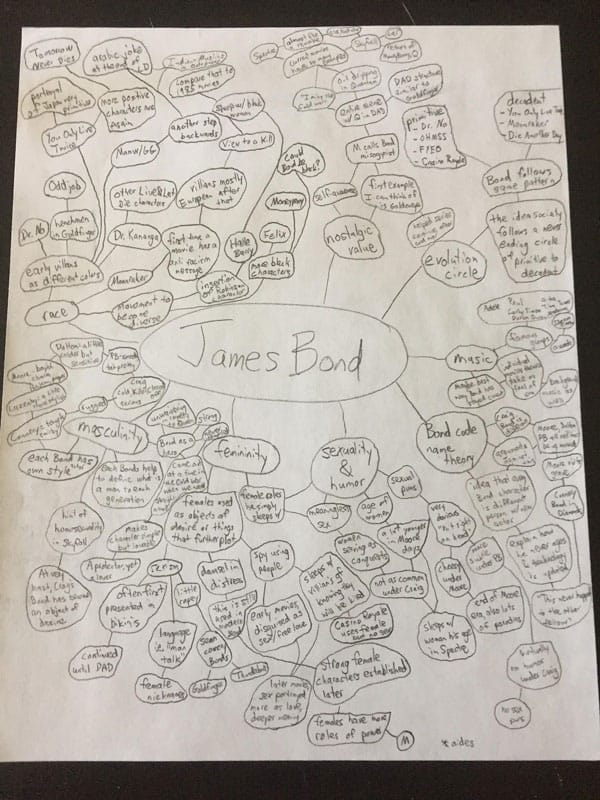
How to Mindmap For Your Book Using the Bubble Method
Everyone has slightly different methods for mindmapping a book. What I’m taking you through is my experience, plus some tips I’ve picked up along the way.
Keep in mind that this is just a base. The real benefit comes from making this process your own and finding what works.
#1 – Make a Central Topic
As you can see with the first mindmap I did for my first book, His World Never Dies: The Evolution of James Bond, my central topic is very, very general — James Bond.
If someone asked me what my book was about, I would be a lot more specific than that, but start very general in the mindmap.
Staying general allows the secondary bubbles—the ones that directly link to your very general topic—to be the main subjects of the chapters in the book.
#2 – Secondary Topics Are Your Central Arguments
More than likely, the general topic is what the subject that you love, but your central arguments are the secondary topics of your mindmap.
They are also what is going to make your book unique.
Returning to my book as an example, I wanted to write a book about the James Bond film series. But many people have done that.
What makes my book unique is the secondary bubbles on my mindmap surrounding the generic topic. Those were the central arguments to my book, and eventually, they became my chapters.
#3 – Branch off from your secondary topics
Referencing my mindmap example again, you can see that each secondary bubble then has multiple bubbles of thoughts coming out of it.
This is where you start to see a “road” for your rough draft.
I wrote down every possible idea I had on each of my topics that links to my general subject. I basically kept writing and making more road until I ran out of paper.
A lot of the ideas I wrote here were already in my head, but I also came up with new ideas through the process of mindmapping.
I never would have came up with all of these concepts if I hadn’t taken the time to mindmap.
How to Mindmap Your Book With the Post-it Notes on Bulletin Board Method
The other way to construct a mindmap is with post-it notes on a bulletin board or wall. If you love post-it notes, this may be the best way for you.
The keys to a successful post-it notes map is the same as the bubble map. The only change is in the display.

In the above example, each big piece of paper with a number in the middle marks a chapter and certain topic pertaining to your larger, general subject. Each colored post-it note applies to a chapter and is the same as the third-tiered bubbles from my own mindmap.
Both techniques will work. You choose which one is best for you!
After completing your first mindmap, you want to repeat this process for every chapter.
The post-it notes picture above is the beginning of the next step of the process, which is then mindmapping each chapter. If you prefer the printer paper mindmapping technique, then repeat the exact same mindmap except plug your more specific topic in the middle.
This allows you more space and enables you to get even more detailed with your roadmap.
Here’s the mindmap for chapter 1 of my book, His World Never Dies: The Evolution of James Bond.
Notice how I included even more details off the “masculinity” bubble in this mindmap than I did in the first one. The main mindmap was definitely a good starting point, but then diving into a mindmap for each major topic or chapter pushed me to brainstorm even further.
This will have the same affect on you and place you well on the path of writing a well organized rough draft.
Tip: Another way to think of your mindmap is to think backward from the outlining phase, which comes directly after the mindmap.
While the bubble roadmap and the post-it bulletin board are the most popular mindmaps, there are other techniques you could try! Here’s one more example of a mindmap:
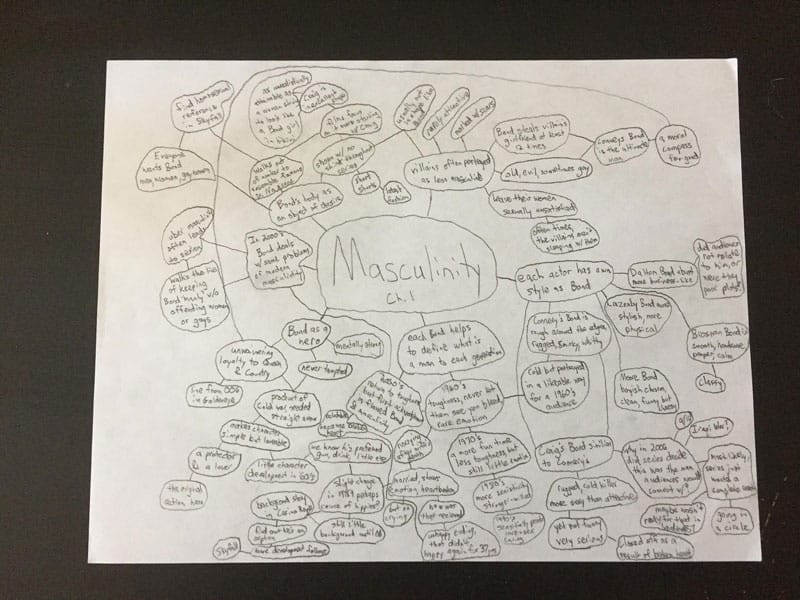
Yes, this looks more like a book outline than mindmap, but if you feel more comfortable with a list like this, then do that.
There’s no right or wrong to mindmapping. The important part is to really begin brainstorming that great book idea and begin organizing your thoughts into possible chapters.
Last big key to a mindmap? Remember, it’s going to change
Let’s return to our grocery store list analogy to end our blog. Even with the best, most-detailed shopping list, we all tend to deviate from it sometimes. Whether an item that you don’t necessarily need is on sale or you find a different brand for cheaper price, audibles to the shopping list happen.
Keep that in mind when you’re mindmapping. This isn’t going to be EXACTLY how your final draft will go. The mindmap process is just supposed to place authors on a road to an organized and well thought-out first draft.
